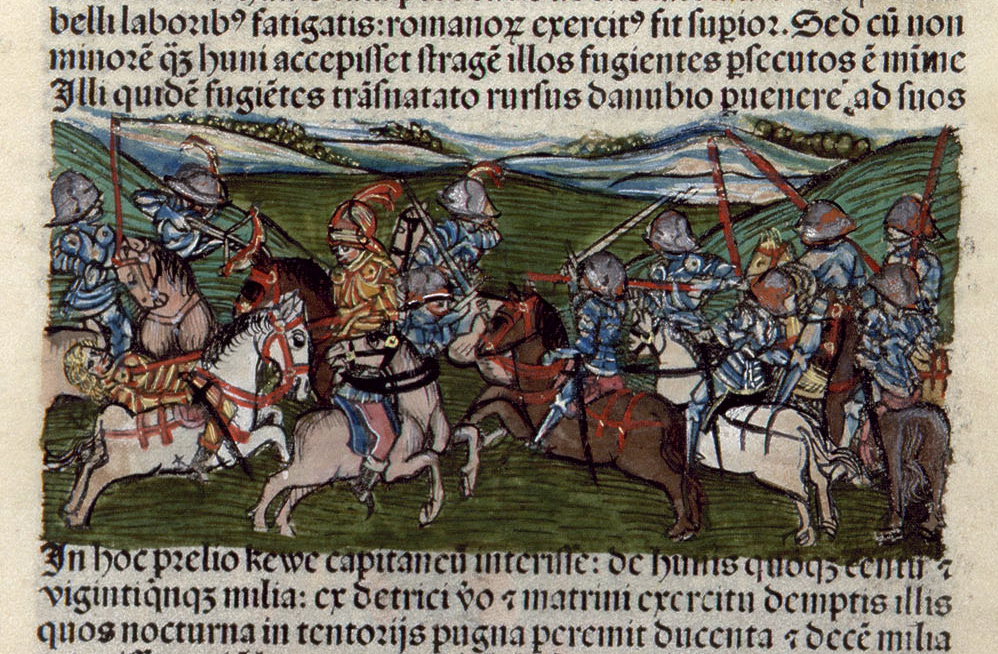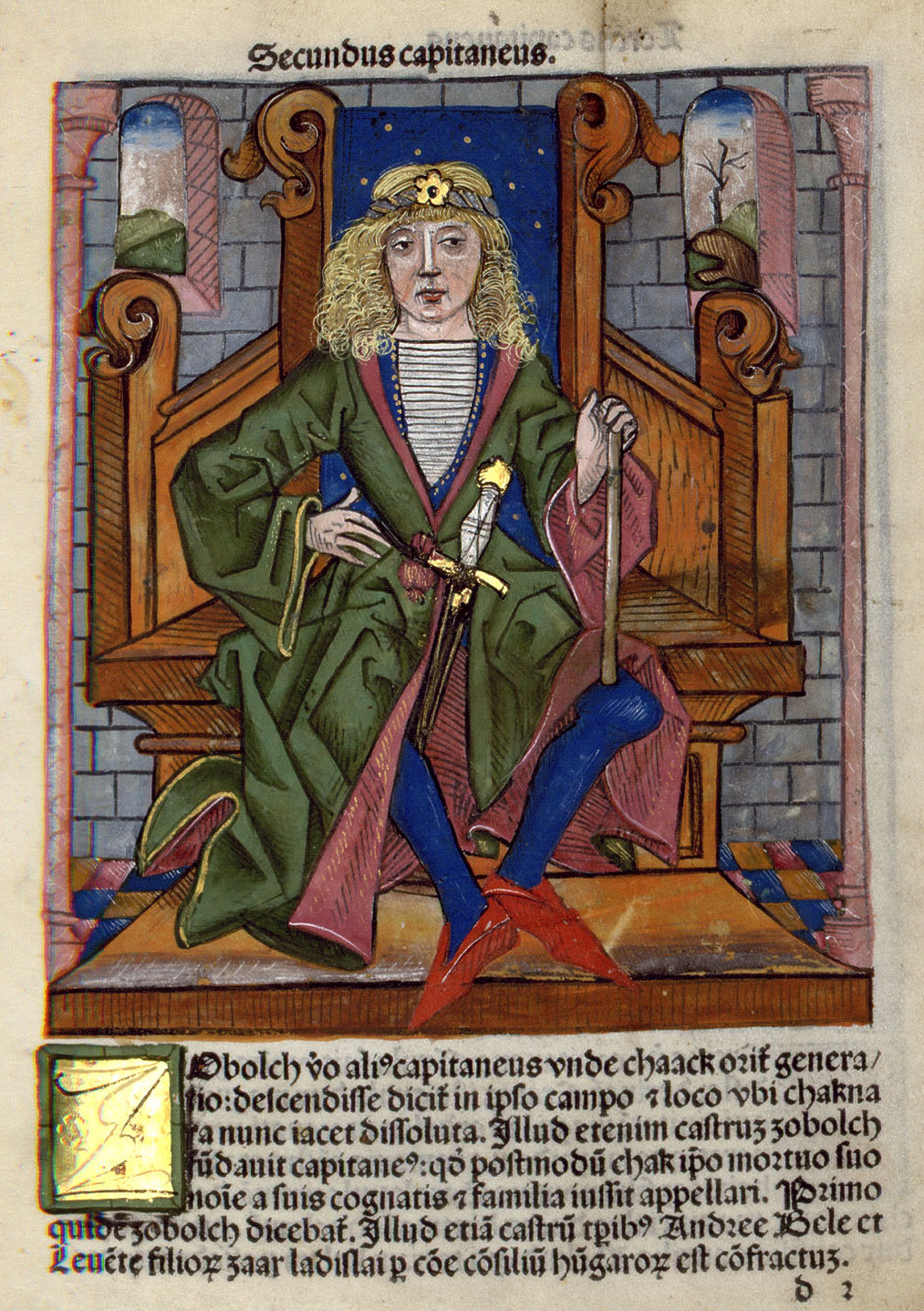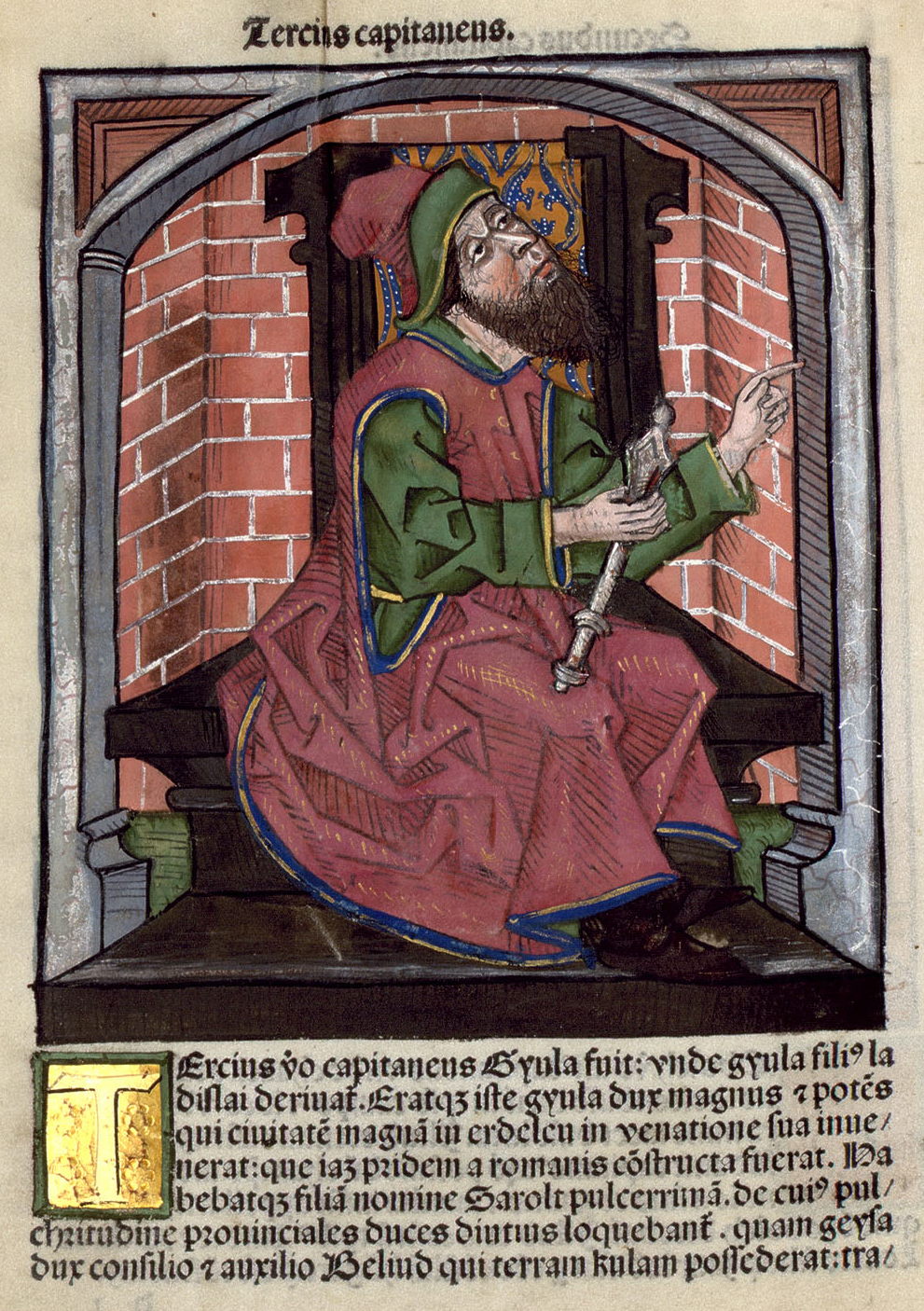Chronica Hungarorum on:
[Wikipedia]
[Google]
[Amazon]
 ''Chronica Hungarorum'' (Chronicle of the Hungarians) is the title of several works treating the early
''Chronica Hungarorum'' (Chronicle of the Hungarians) is the title of several works treating the early
File:Thuróczy krónika - 1.jpg
File:Thuróczy krónika - 2.jpg
File:Thuróczy krónika - 3.jpg
File:Thuróczy krónika - 4.jpg
File:Thuróczy krónika - Mátyás király nagy birodalmi címere.jpg
File:Thuróczy krónika - Attila király (4).jpg
File:Thuróczy krónika - Szent László király (1).jpg
File:Thuróczy krónika - Szent László király (2).jpg
The images are listed in the same order as their appearance in the chronicle.
{, class="wikitable" width="100%"
! width="30%" , Illustration
! width="70" , Description
, -
,

, The Great Coats of Arms of King Matthias Corvinus of Hungary * The great coats of arms of King

, Saint Ladislaus Chases the Cuman Warrior Who Kidnapped a Girl * Two scene in one picture. Saint Ladislaus is chasing and fighting a duel with a

, Page With Golden Frame * Flower decorations in golden frame. , - ,

, Battle of the Tárnok Valley , - ,

, King Attila * King

, Árpád, the First Captain *

, Szabolcs, the Second Captain * Szabolcs, Hungarian chieftain from the seven chieftains of the Hungarians. , - ,

, Gyula, the Third Captain * Gyula, Hungarian chieftain from the seven chieftains of the Hungarians. , - ,

, Kund, the Fourth Captain * , Lehel, the Fifth Captain
*
, Lehel, the Fifth Captain
*

, Vérbulcsú, the Sixth Captain * Vérbulcsú, Hungarian chieftain from the seven chieftains of the Hungarians. , - ,

, Örs, the Seventh Captain * Örs, Hungarian chieftain from the seven chieftains of the Hungarians. , - ,

, King Saint Ladislaus I * Saint Ladislaus.
Bibliotheca Corviniana Digitalis – A Thuróczy-krónika
Hungarian books History of Hungary History of the Hungarians Kingdom of Hungary Medieval Kingdom of Hungary 9th century in Hungary 10th century in Hungary 11th century in Hungary 12th century in Hungary 13th century in Hungary 14th century in Hungary 15th century in Hungary 15th-century illuminated manuscripts 15th-century history books 15th-century Latin books Illuminated histories
 ''Chronica Hungarorum'' (Chronicle of the Hungarians) is the title of several works treating the early
''Chronica Hungarorum'' (Chronicle of the Hungarians) is the title of several works treating the early Hungarian history
Hungary in its modern (post-1946) borders roughly corresponds to the Great Hungarian Plain (the Pannonian Basin). During the Iron Age, it was located at the crossroads between the cultural spheres of the Celtic tribes (such as the Scordisci, Boii ...
.
Buda Chronicle
A popular chronicle partly based on the ''Chronicon Pictum'' (entitled just ''Chronica Hungarorum'') was circulated in a printed form. It is also known as the ''Buda Chronicle
''Chronica Hungarorum'' (Chronicle of the Hungarians) is the title of several works treating the early Hungarian history.
Buda Chronicle
A popular chronicle partly based on the ''Chronicon Pictum'' (entitled just ''Chronica Hungarorum'') was c ...
''. It was produced in 1473 by András Hess
András Hess set up a printing press in Buda in 1472.
He printed the first book in Hungary on 5 June 1473 in his Buda press. Hess was probably of German origin. He dedicated the book, the Chronica Hungarorum or Buda Chronicle ( hu, Budai Krónika) ...
and is the first incunabulum ever printed in Hungary (Buda, András Hess
András Hess set up a printing press in Buda in 1472.
He printed the first book in Hungary on 5 June 1473 in his Buda press. Hess was probably of German origin. He dedicated the book, the Chronica Hungarorum or Buda Chronicle ( hu, Budai Krónika) ...
, 1473, 70 fol., 2º.)
It relates the history of Hungary
Hungary ( hu, Magyarország ) is a landlocked country in Central Europe. Spanning of the Carpathian Basin, it is bordered by Slovakia to the north, Ukraine to the northeast, Romania to the east and southeast, Serbia to the south, Cr ...
from the earliest times to the coronation of King Matthias. Eleven copies of the chronicle are known to survive, two of them in Hungary: one in the National Széchényi Library
The National Széchényi Library ( hu, Országos Széchényi Könyvtár) (OSZK) is a library in Budapest, Hungary, located in Buda Castle. It is one of two Hungarian national libraries, the other being University of Debrecen Library.
History
The ...
and another in the Budapest University
Budapest (, ; ) is the capital and most populous city of Hungary. It is the ninth-largest city in the European Union by population within city limits and the second-largest city on the Danube river; the city has an estimated population o ...
Library.
Thuróczy Chronicle
The third chronicle entitled ''Chronica Hungarorum'', partly based on the ''Chronicon Pictum
The ''Chronicon Pictum'' ( Latin for "illustrated chronicle", English: ''Illuminated Chronicle'' or ''Vienna Illuminated Chronicle'', hu, Képes Krónika, sk, Obrázková kronika, german: Illustrierte Chronik, also referred to as ''Chronica Hun ...
'', was produced by Johannes de Thurocz () , the first layman known to have written a book in the Kingdom of Hungary
The Kingdom of Hungary was a monarchy in Central Europe that existed for nearly a millennium, from the Middle Ages into the 20th century. The Principality of Hungary emerged as a Christian kingdom upon the Coronation of the Hungarian monarch, c ...
. This work (Brno
Brno ( , ; german: Brünn ) is a city in the South Moravian Region of the Czech Republic. Located at the confluence of the Svitava and Svratka rivers, Brno has about 380,000 inhabitants, making it the second-largest city in the Czech Republic ...
, 1488, Augsburg
Augsburg (; bar , Augschburg , links=https://en.wikipedia.org/wiki/Swabian_German , label=Swabian German, , ) is a city in Swabia, Bavaria, Germany, around west of Bavarian capital Munich. It is a university town and regional seat of the ' ...
, 1488) presents events as seen by an educated nobleman. The chronicle is described in the article on the author.

, The Great Coats of Arms of King Matthias Corvinus of Hungary * The great coats of arms of King
Matthias Corvinus
Matthias Corvinus, also called Matthias I ( hu, Hunyadi Mátyás, ro, Matia/Matei Corvin, hr, Matija/Matijaš Korvin, sk, Matej Korvín, cz, Matyáš Korvín; ), was King of Hungary and Croatia from 1458 to 1490. After conducting several m ...
of Hungary of 1485 in the first page of the Chronica Hungarorum. The coat of arms of the countries of King Matthias Corvinus
Matthias Corvinus, also called Matthias I ( hu, Hunyadi Mátyás, ro, Matia/Matei Corvin, hr, Matija/Matijaš Korvin, sk, Matej Korvín, cz, Matyáš Korvín; ), was King of Hungary and Croatia from 1458 to 1490. After conducting several m ...
of Hungary and Queen Beatrice of Aragon.
* In the center, the united coat of arms of Matthias Matthias is a name derived from the Greek Ματθαίος, in origin similar to Matthew.
People
Notable people named Matthias include the following:
In religion:
* Saint Matthias, chosen as an apostle in Acts 1:21–26 to replace Judas Iscariot
* ...
and Beatrice:
** Matthias Matthias is a name derived from the Greek Ματθαίος, in origin similar to Matthew.
People
Notable people named Matthias include the following:
In religion:
* Saint Matthias, chosen as an apostle in Acts 1:21–26 to replace Judas Iscariot
* ...
, quartered shield: 1: Hungarian double cross and trimount, 2: Hungarian Árpád stripes, 3: Bohemia
Bohemia ( ; cs, Čechy ; ; hsb, Čěska; szl, Czechy) is the westernmost and largest historical region of the Czech Republic. Bohemia can also refer to a wider area consisting of the historical Lands of the Bohemian Crown ruled by the Bohem ...
, 4: Hunyadi family
The Hunyadi family was one of the most powerful noble families in the Kingdom of Hungary during the 15th century. A member of the family, Matthias Corvinus, was King of Hungary from 1458 until 1490, King of Bohemia (ruling in Moravia, Lowe ...
.
** Beatrice, quartered shield: 1–3: vertically in thirds: a: Hungarian Árpád stripes, b: Anjou lilies, c: Jerusalem
Jerusalem (; he, יְרוּשָׁלַיִם ; ar, القُدس ) (combining the Biblical and common usage Arabic names); grc, Ἱερουσαλήμ/Ἰεροσόλυμα, Hierousalḗm/Hierosóluma; hy, Երուսաղեմ, Erusałēm. i ...
, 2–4: Aragon
Aragon ( , ; Spanish and an, Aragón ; ca, Aragó ) is an autonomous community in Spain, coextensive with the medieval Kingdom of Aragon. In northeastern Spain, the Aragonese autonomous community comprises three provinces (from north to s ...
.
* Clockwise in the outer circle: 1: Bohemia
Bohemia ( ; cs, Čechy ; ; hsb, Čěska; szl, Czechy) is the westernmost and largest historical region of the Czech Republic. Bohemia can also refer to a wider area consisting of the historical Lands of the Bohemian Crown ruled by the Bohem ...
, 2: Luxemburg, 3: Lower Lusatia
Lower Lusatia (; ; ; szl, Dolnŏ Łużyca; ; ) is a historical region in Central Europe, stretching from the southeast of the German state of Brandenburg to the southwest of Lubusz Voivodeship in Poland. Like adjacent Upper Lusatia in the sou ...
, 4: Moravia
Moravia ( , also , ; cs, Morava ; german: link=yes, Mähren ; pl, Morawy ; szl, Morawa; la, Moravia) is a historical region in the east of the Czech Republic and one of three historical Czech lands, with Bohemia and Czech Silesia.
The ...
, 5: Austria
Austria, , bar, Östareich officially the Republic of Austria, is a country in the southern part of Central Europe, lying in the Eastern Alps. It is a federation of nine states, one of which is the capital, Vienna, the most populous ...
, 6: Galicia
Galicia may refer to:
Geographic regions
* Galicia (Spain), a region and autonomous community of northwestern Spain
** Gallaecia, a Roman province
** The post-Roman Kingdom of the Suebi, also called the Kingdom of Gallaecia
** The medieval King ...
, 7: Silesia
Silesia (, also , ) is a historical region of Central Europe that lies mostly within Poland, with small parts in the Czech Silesia, Czech Republic and Germany. Its area is approximately , and the population is estimated at around 8,000,000. S ...
, 8: Dalmatia
Dalmatia (; hr, Dalmacija ; it, Dalmazia; see names in other languages) is one of the four historical regions of Croatia, alongside Croatia proper, Slavonia, and Istria. Dalmatia is a narrow belt of the east shore of the Adriatic Sea, str ...
.
, -
, 
, Saint Ladislaus Chases the Cuman Warrior Who Kidnapped a Girl * Two scene in one picture. Saint Ladislaus is chasing and fighting a duel with a
Cuman
The Cumans (or Kumans), also known as Polovtsians or Polovtsy (plural only, from the Russian exonym ), were a Turkic nomadic people comprising the western branch of the Cuman–Kipchak confederation. After the Mongol invasion (1237), many sough ...
warrior. The legends related to Saint Ladislaus, the events of the Battle of Kerlés
The Battle of Kerlés ( hu, kerlési csata) or Battle of Chiraleș, also known as the Battle of Cserhalom, was an engagement between an army of Pechenegs and Ouzes commanded by OsulMedieval chronicles wrote that the invaders were Cumans or Pech ...
in 1068 described in the chronicle and the scene of the girl kidnapping had a deep impact on posterity. The scene of the fight of the Christian king symbolizes the victory of Christianity over paganism.
, -
, 
, Page With Golden Frame * Flower decorations in golden frame. , - ,

, Battle of the Tárnok Valley , - ,

, King Attila * King
Attila
Attila (, ; ), frequently called Attila the Hun, was the ruler of the Huns from 434 until his death in March 453. He was also the leader of a tribal empire consisting of Huns, Ostrogoths, Alans, and Bulgars, among others, in Central and E ...
.
, -
, 
, Árpád, the First Captain *
Árpád
Árpád (; 845 – 907) was the head of the confederation of the Magyar tribes at the turn of the 9th and 10th centuries. He might have been either the sacred ruler or '' kende'' of the Hungarians, or their military leader or '' g ...
, Grand Prince of the Hungarians.
, -
, 
, Szabolcs, the Second Captain * Szabolcs, Hungarian chieftain from the seven chieftains of the Hungarians. , - ,

, Gyula, the Third Captain * Gyula, Hungarian chieftain from the seven chieftains of the Hungarians. , - ,

, Kund, the Fourth Captain *
Kund
Kund is a village and one of the 51 Union Councils (administrative subdivisions) of Khushab District in the Punjab Province of Pakistan
Pakistan ( ur, ), officially the Islamic Republic of Pakistan ( ur, , label=none), is a country i ...
, Hungarian chieftain from the seven chieftains of the Hungarians.
, -
,  , Lehel, the Fifth Captain
*
, Lehel, the Fifth Captain
* Lehel
Lehel ( hu, Lél; died 955), a member of the Árpád dynasty, was a Magyar chieftain and, together with Bulcsú, one of the most important figures of the Hungarian invasions of Europe. After the Magyar defeat at the Battle of Lechfeld, he was ex ...
, Hungarian chieftain from the seven chieftains of the Hungarians.
, -
, 
, Vérbulcsú, the Sixth Captain * Vérbulcsú, Hungarian chieftain from the seven chieftains of the Hungarians. , - ,

, Örs, the Seventh Captain * Örs, Hungarian chieftain from the seven chieftains of the Hungarians. , - ,

, King Saint Ladislaus I * Saint Ladislaus.
External links
Bibliotheca Corviniana Digitalis – A Thuróczy-krónika
Hungarian books History of Hungary History of the Hungarians Kingdom of Hungary Medieval Kingdom of Hungary 9th century in Hungary 10th century in Hungary 11th century in Hungary 12th century in Hungary 13th century in Hungary 14th century in Hungary 15th century in Hungary 15th-century illuminated manuscripts 15th-century history books 15th-century Latin books Illuminated histories